The Consumer Price Index dropped -07% for January, the largest monthly drop since December 2008 and the steepest monthly decline in a series of seven. Gasoline prices plummeted -18.7%, the steepest since December 2008. The drop in gas overwhelmed the Consumer Price Index and was the cause of the overall drop. Inflation with setting gasoline prices as unchanged would have shown a 0.1% increase in CPI. CPI measures inflation, or price increases.

CPI has now decreased -0.1% from a year ago. Yearly CPI hasn't declined since October 2009. CPI is in deflation has it's own set of major problems as evidenced by 2009, also caused in a large part by a pop in the oil price balloon.
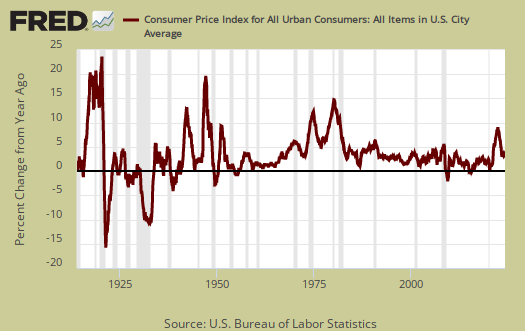
Core inflation, or CPI with all food and energy items removed from the index, has increased 1.6% for the last year. Core CPI is one of the Federal Reserve inflation watch numbers and 2.0% per year is their target rate. Deflation is a grave concern for the Federal Reserve. Federal Reserve Chair Janet Yellen testified recently that the low inflation numbers would continue to keep interest rates effectively zero. Graphed below is the core inflation change from a year ago.

Core CPI's monthly percentage change is graphed below. This month core inflation increased 0.1%.
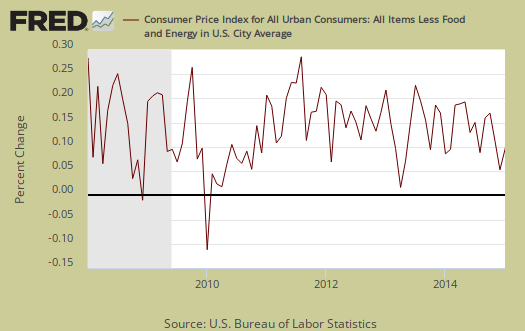
Energy overall declined -9.7% for the month and energy costs are now down -19.6% from a year ago. These are just astounding figures in the rapid decline of energy prices. The BLS separates out all energy costs and puts them together into one index. The individual energy indexes are even more dramatic. Gasoline dropped -18.7% for the month and has declined -35.4% for the year. Fuel oil dropped -9.9% for the month, down -29.7% for the year. Natural gas is now down -0.4% from a year ago with a monthly decline of -3.4%. Only electricity increased and this time by 0.9% for the month and is now up 32.5% for the year. Graphed below is the overall CPI energy index.

Graphed below is the CPI gasoline index only, which shows gas prices wild ride and dead weight drop.
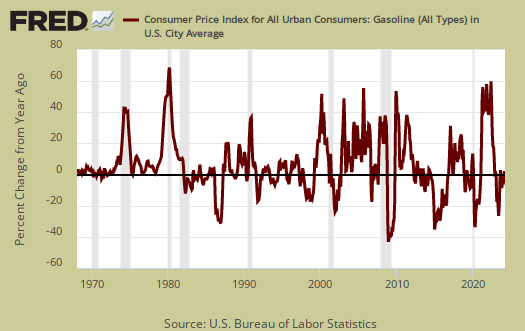
Core inflation's components include shelter, transportation, medical care and anything not food or energy. This month the personal care index increased 0.6%, the highest in the history of the series. How odd, other than that, the usual suspect, housing costs. continued on it's rise. The shelter index is comprised of rent, the equivalent cost of owning a home, hotels and motels. Shelter increased 0.3% and is up 2.9% for the year as lodging away from home increased 1.3%. Rent increased 0.2% for the month, 3.4% for the year. This is the national average,, rents in some areas of the country are just soaring. Home prices are increasing as reflected in the cost for home owners increased 2.6% for the past year as well. Graphed below is rent, where cost increases hits the people who can least afford it.
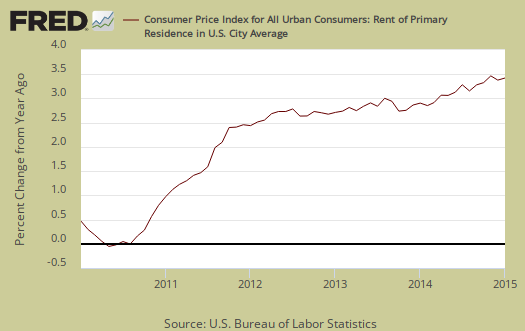
Medical care services showed no change this month yet are up 2.6% for the year. Graphed below is the overall medical care index change from a year ago.
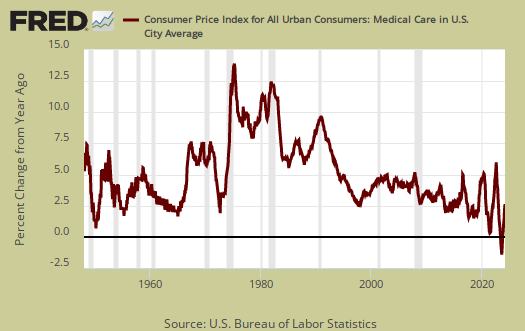
Below is a graph of the medical commodities index, which in large part consists of prescription drug prices, actually decreased -0.3% for month, but is up 3.9% for the past year. Notice the beyond belief never ending increases since 1975 in the below graph. Meanwhile Americans are force feed expensive pharmaceutical marketing campaigns to the point that act, by itself, is probably making people sick.
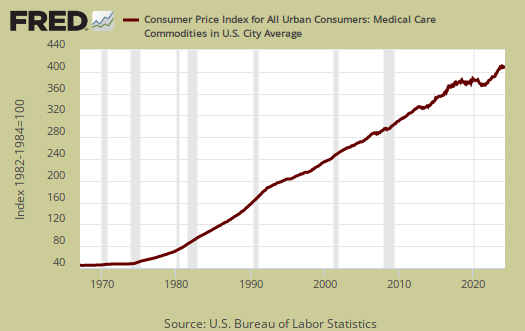
Even food inflation was impacted this month as overall there was no change in the index. Food and beverages have now increased 3.2% from a year ago. They are claiming your groceries, aka food at home, declined by -0.3% for the month, yet is still up 3.3% for the year. Eating out, or food away from home increased 0.3% from last month and is up 3.1% from a year ago.
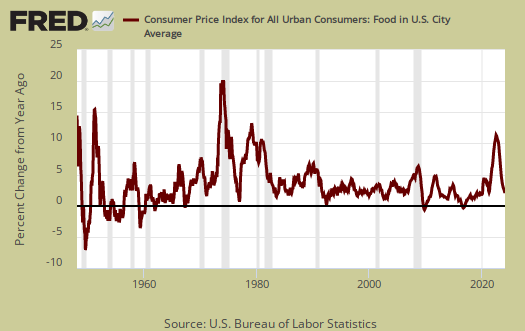
Graphed below is the food at home index, which is deceptive due to the BLS assuming one will substitute items when a large increase occurs.

Individual food items so one gets a better feel for what is going on. Beef & veal are up 19.0% for the year with a monthly 0.1% increase. Meats, poultry, fish, and eggs overall have increased 8.7% for the last year. nbsp;It is not your imagination, groceries have increased dramatically. Plain ole hamburger for example, has increased 21%.
The BLS released real hourly earnings for January. With our new deflation, we get the illusion that real wages are soaring and of course they are not. Real means wages adjusted for inflation. The average hourly real wage rose 1.2%. This occurred because wages actually did increase 0.5% for all but that combined with our -0.7% price drop makes real wages increase by 1.2%. The wage is now $10.55 and has increased 2.4% from a year ago. Weekly real earnings have increased 3.0% for the year. People were working 0.6% more hours per week in January than December.
CPI details
The DOL/BLS does take yearly surveys on where the money goes in the monthly budget, but as one can see, food and energy are significant amounts of the monthly finances. Run away costs in these two areas can break the bank, so can food. Additionally CPI uses substitution, so if flour goes through the roof, somehow we're all just fine with oats and prices didn't really overall increase much. Here is the BLS CPI site, where one can find much more details, information on calculation methods and error margins.
Other CPI report overviews, unrevised, although most graphs are updated, are here. If you're wondering why the graphs display different figures from the text, the graphs calculate percentages from the index and do not round. The actual data from the BLS report does round to one decimal place. In other words, 0.05% is rounded to 0.1%.

Recent comments